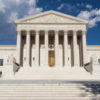Benjamin Garland
March 9, 2017
Samuel Roth
“If Roth were not the opportunistic, irascible, and sometimes megalomaniacal idealist he was, the early 1960s advances in freedom of expression would not have happened when they did” – Jay Gertzman1
Samuel Roth (Hebrew name Mishillim) was born in 1894 in a shtetl in the Eastern European region between Austria and Poland then known as Galicia. His family emigrated to New York in 1904, when he was about 10 years old.
Roth worked at some odds and ends jobs and then began writing poetry and resolved to go into publishing, where he would continually push the boundaries of what was considered acceptable throughout his entire career, ultimately getting himself arrested no less than 8 times and serving a total of nine years of his adult life in prison.
Having his offices raided at least once a year from 1927 to 1931, Roth was caught and charged for distributing a myriad of banned and obscene materials, such as the infamous Lady Chatterley’s Lover by D.H. Lawrence (which is discussed in part 4) and portions of Ulysses by James Joyce (which is discussed in part 1). Both were unauthorized.
The latter especially was seen by his peers as a serious breach of ethics, resulting in his excommunication from literary circles following a letter of protest signed by 167 writers and intellectuals, such as Ernest Hemingway and Albert Einstein.
Roth was a very colorful figure, assuming many roles in his life: “smut king,” serious intellectual, family man, literary pariah, “free speech” martyr, and even, for a time: self-hating Jew.
In a bizarre episode in 1934, after a series of events which “suddenly, blindingly,” led him to the realization that “all the evils” of his life had been “perpetrated by Jews,” Roth wrote and published the startling book Jews Must Live, in which he confirmed many of the traditional anti-Jewish claims.
Roth writes of how he had shed his innate cognitive dissonance regarding the true nature of his tribe after losing his business to a conspiracy of Jew “vultures” and “shysters,” deciding then to be “the first Jew to arise and tell the truth about them.”
“I am a Jew who has been brought to the point where he so loathes his people that he thinks in terms of their destruction,” he wrote.
While Roth never shared “the Jewish contempt for the goyim” – which, he explained, “is part and parcel of all Jewish psychology” – he claimed he had not written the book to “curry favor with the gentile,” but rather to tell the truth as he saw it, for cathartic purposes, as “something of an organic necessity.”
In it, he wrote that the Jews had made a “hideous swamp of Western Civilization,” that anti-Semitism is a “primal instinct of mankind” which preserves the race against “total destruction,” and that the Jews have deserved all of their pogroms and persecutions (see footnote).2
“Our major vice of old, as of today,” he wrote, “is parasitism. We are a people of vultures living on the labor and the good nature of the rest of the world.”
Jews, he explained, “are firmly convinced that they will eventually inherit the earth,” and they consider themselves its “natural masters.” “It was practically a moral obligation on the part of every conscientious Jew to fool and cheat the goy wherever and whenever possible.”
Leolom Tickah (“always take”) is the way and the motto of the Jew, according to Roth. “When the goy had been cheated business was good,” he wrote. “When the Jew had come out even, business was very bad, indeed.”
“Little Jews,” he continued, are taught in Hebrew school that they are “the salt of the earth” and that everything in it “belongs to them”; that “as a racial Jew – apart from all the other races – he is waging an old war against his neighbors”; and that “to do manual labor for one’s livelihood, is the very worst state the young Jew can fall to, something to make him really ashamed and humiliated.”
He asserted that Jews had done nothing but stab America, “the most patient of the western nations,” in the back: “There is blood in the eye of Uncle Sam as he looks across the ringside at the pudgy, smiling Uncle Moses.”
“It is my honest belief,” he wrote, “that nothing the Jew does in America is essential to its welfare. On the contrary, a great deal of what the American Jew does is subversive of America’s best interests.”

Ironically, Roth was himself a supreme example of a “subversive” Jew, one who did incalculable damage through his relentless insistence on distributing obscene and pornographic materials.
This seeming paradox is likely explained by the fact that Roth actually believed that he was doing the right thing fighting against censorship – a sort of freedom crusade.
While being grilled by the Senate Subcommittee on Obscene and Pornographic Materials in 1955 (see part 2) on the ethics of involving his wife in his dirty business, he shouted: “The only thing I can tell you is that we were right.”
Judging by the transcript, where it can be read that the officials had to tell him to “sit down,” it had been a dramatic scene.3

Roth testifying before the 1955 Senate Subcommittee on Obscene and Pornographic Materials.
Roth denounced Jews Must Live almost immediately after publishing, and it remained a stain on his reputation and an embarrassment that he was forced to carry around for the rest of his life. It also served to further alienate him from the heavily Jewish literary community, and, as a result, he began publishing obscene, sensational and pornographic material almost exclusively following 1934.
He was again charged for this activity in 1935, for which he was acquitted; and then again in 1936, for which he received 3 years, serving until 1939; and yet again in 1942, for which he received 2 years probation.
After a few more skirmishes with the law and postal authorities, Roth was finally indicted on four counts of obscenity, for which he was sentenced to 5 years imprisonment and a $5000 fine, in 1956.
The charge stemmed from two of Roth’s publications: the periodical Good Times, and the hardbound journal American Aphrodite. The latter included a story in which a unicorn kneels down and “laps” up its own semen after having been masturbated by one of the characters.4
On appeal to the Second Circuit Court of New York, the decision was affirmed by all judges. One Jewish judge, however – while not dissenting, because he felt it was not his place to do so as a judge on a lower court – wrote a powerful concurrence in which he implored the Supreme Court to finally weigh in on the matter of obscenity and set a new national precedent.

Jerome Frank
The judge, Jerome Frank, who was heavily influenced by the writing and research of Morris Ernst and Alfred Kinsey, and a Freud devotee (all of whom are discussed further in part 5), made a very slick case for the liberalization of obscenity laws.5
Frank’s concurring opinion, which hit the law world like an earthquake, highlighted many seeming contradictions and hypocrisies in the regulation of obscenity – of which a shrewd law expert can inevitably find many.6
Thanks largely to Frank’s opinion, the Supreme Court was at long last ready to address the morass of obscenity law.
The first case they decided was that of Butler v. Michigan, in early 1957, in which they cemented the Ulysses decision as a national precedent. The Ulysses decision, as discussed in part 1, altered the original American obscenity “test” – the Hicklin test – from one that judged a book by the effect it would have on those who were “susceptible” to immoral influence (i.e. children or perverts), to its effect on the “average” person (whatever that means).
The Jew Felix Frankfurter famously wrote in the court’s decision:
The State insists that, by thus quarantining the general reading public against books not too rugged for grown men and women in order to shield juvenile innocence . . . Surely, this is to burn the house to roast the pig.7
Butler was not terribly significant though, as the Ulysses decision had already been standard in the lower courts for many years.
What the obscenity law activists were really clamoring for, was the question of constitutionality: Is obscenity protected by the First Amendment, which says the government shall make no law “abridging the freedom of speech,” or is it not?

Felix Frankfurter
Roth’s case, which came next, tackled this issue head on. The verdict: No, obscenity is not protected by the First Amendment (6-3 affirmed).
“[I]mplicit in the history of the First Amendment is the rejection of obscenity as utterly without redeeming social importance,” the decision reads.
Roth, after contacting the FBI and offering to go undercover in Mexico and infiltrate the leftist expatriate movement as an informant, in a last ditch effort to avoid his sentence, was imprisoned and served for the full 5 years.8
While the court had declared that obscenity was not protected by the First Amendment, the definition of what would be considered obscene had now been broadened considerably. Materials would now have to be “utterly without redeeming social importance” and pass what became known as the Roth test, which was so ridiculously convoluted and sloppily worded it gave lawyers almost endless leeway:
Whether to the average person, applying contemporary community standards, the dominant theme of the material taken as a whole appeals to prurient interest.
Who is the “average person”? How does one measure “contemporary community standards”? What exactly does “taken as a whole” mean? How much need not appeal to “prurient interest” in order for prurience not to be the considered the “dominant theme” of a work? Whose “prurient interest” is in question? How much “redeeming social importance” does it take to save a work? Whose opinion do you go by?
Etc., etc., ad infinitum.
For this reason Roth v United States was – and still remains – by far the most significant decision in the history of American obscenity law.
While in prison, Roth wrote his final book, My Friend Yeshua. He had experienced vivid hallucinations throughout his entire life, beginning when he saw a “beast” rising out of a stream as a young child in the shtetl.9
Roth claimed that he had talked with Yeshua (Jesus) on at least four different occasions, and My Friend Yeshua was his attempt at reconciling Jews and gentiles, which he saw as the only way to end anti-Semitism and their eternal conflict.
“If not I, who?” Roth would say, grandiosely.
“All differences between Jews and their persecutors must be abolished,” Yeshua allegedly had told him, during a vision.10
By the time Roth was released in 1961, what was now considered acceptable made what he had published look like Sesame Street, largely due to his case.
Paradoxically, the precedent set by the Roth decision would’ve dictated that the material in question in Roth’s own case was indeed not legally obscene, because it could’ve been shown to have had “redeeming social importance,” but since Roth’s defense was argued strictly on constitutional grounds, he was still convicted.
“I ALONE DID NOT BENEFIT FROM THE DECISION IN MY CASE,” he lamented (emphasis his).11
Ultimately, he was satisfied with the outcome though, now being able to see himself as a martyr for the greater good.
“However little I have accomplished for myself, I have won the greatest victory against book censorship in modern times,” he wrote, his grandiosity again surfacing, as he continued: “I am not complaining. It took only ten years of my life to ease the laws of my country toward the tenderer organs of its literature. I said, Let our books live, and now they live.”12
In part 4, we will look at the watershed decisions from between the years 1959 and 1967, which were all directly influenced by Roth, before getting into the cultural conditions that created the environment in which these decisions were able to take place, in parts 5, 6, and 7.
If you enjoy this series, please consider tipping the author: 14KQkvSS26QbY264yLXK586GuYZkmM7BS4
Notes
- Jay Gertzman, Samuel Roth: Infamous Modernist, 2013, p.264
- Samuel Roth, Jews Must Live: An Account of the Persecution of the World by Israel on All the Frontiers of Civilization, 1934, p.177-178 footnote:“The next time you read about a particularly bloody pogrom and pause to wonder how Christians, dedicated to a religion of mercy, can exercise so much brutality against the Jews, remember that the Jew wheedles all the mercy out of his neighbors in the ordinary course of business. He lies and cheats until he is caught. When caught, instead of accepting punishment, he moans and tears his hair, invokes the sores of ancestors in their graves and living relations at the point of death in hospitals, until the wronged gentile, nauseated, lets him go. Then, thumbing his nose at the gentile behind his back, the Jew goes about his business the same way, lying and cheating now doubly to make up for lost time. A pogrom is usually the climax of years of such relentless goading. Do you wonder that when the final reckoning comes the gentile is absolutely merciless?”
- Juvenile Delinquency: Obscene and Pornographic Materials, 1955, p.203
- Edward de Grazia, Girls Lean Back Everywhere: The Law of Obscenity and the Assault on Genius, 1992, p.283
- Leigh Ann Wheeler, How Sex Became a Civil Liberty, 2012, p.70
- See United States v. Roth, 237 F.2d 796 (2d Cir. 1956)
- Butler v. Michigan, 352 U.S. 380 (1957)
- Whitney Strub, Obscenity Rules: Roth v. United States and the Long Struggle Over Sexual Expression, 2013, p.180
- Jay Gertzman, “The Strange Case of Samuel Roth: A Demon in Galicia, Its Exorcism, and What Happened After,” The Jewish Magazine, April 2009 Passover Edition
- Gertzman, p.16
- Strub, p.182
- Gertzman, p.264







